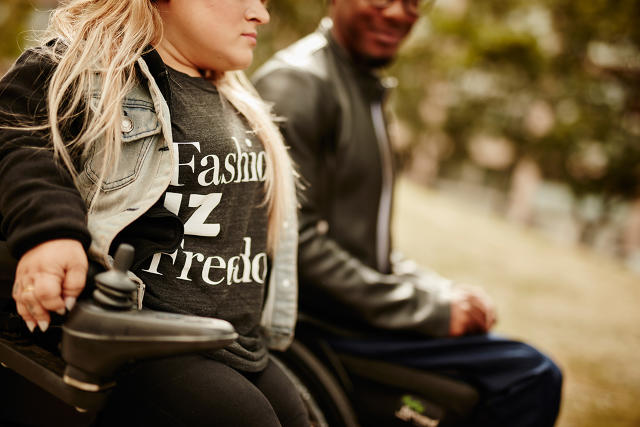The stylish fashion brand for those in wheelchairs has become a champion for wheelchair accessibility.
How much thought do you give to the process of putting on your clothes each day? Not what you’re going to wear, but the actual act of getting dressed? What about how you’re going to get into your local coffee shop on the way to work? The most likely answer is “little-to-none.” For people in wheelchairs, however, such things can be a burden.
Since 2004, fashion brand IZ has been helping people with the sartorial question by providing beautifully designed and highly functional clothing designed specifically for the needs of wheelchair bound consumers. Now the brand is ratcheting up its efforts to help the non-able bodied by using its products as a vehicle to make the world more accessible.
Through its Access10 advocacy campaign, 10% of every sale is now invested in programs that increase accessibility—specifically, building ramps in communities across North America through partnerships with organizations like Stop Gap Foundation.
Access10 was created with Toronto agency The Garden, and the result of a strategic pivot for IZ. The brand came to The Garden looking for a print campaign that would help them reach a target audience that is bound by their mobility and not traditional demographics, says agency co-founder and creative director Shane Oglivie.
“IZ Adaptive was a pioneer in the fashion industry, having been one of the first in the world to create a completely new category of fashion,” says Ogilvie. “But like any pioneering business, while the potential was obvious, there were many challenges that included figuring out now to efficiently and effectively reach a very niche target audience. After an initial discussion and asking a number of questions, we challenged their assumption that a print ad was what they needed right now. After a few years establishing the business, it felt like IZ was ready to evolve to the next level and that would require more than just a tactical short-term print campaign.”
The discussion allowed The Garden to help IZ define a strong purpose and personality for the brand, one that would act as a filter and a strategic decision-making tool to shape all future brand activities. The company went from being an accessible fashion company to a company with a broader purpose and mission.
While Ogilvie acknowledges that advocacy and social responsibility models aren’t a new concept, he notes that typically the customer and beneficiary are two separate groups. “In the case of Access10, we’ve been able to create an opportunity to empower the customers themselves and allow them to directly impact their own lives in a very real and tangible way with every purchase they make,” he says. And the initiative also gives IZ a unique way to reach its broadly dispersed group of customers.
The Access10 advocacy program is only one part of the brand refresh for IZ. The Garden also collaborated with founder Izzy Camilleri—a celebrated Canadian fashion designer who’s outfitted A-listers such as Angelina Jolie, David Bowie, Jennifer Lopez, and Meryl Streep—on refreshing and refining the product line so that it delivered on the new brand promise of being fashion-forward, fun, and sexy.
“Adaptive or functional clothing as a category has historically been approached in a way that thinks of the end user only in terms of their limitations,” says Ogilvie. “And this type of clothing is typically only marketed as a disability tool. Functionality is the first consideration in this category; fashion is rarely considered at all. So you typically end up with brands that are built with very little thought around creating an aspirational or emotional connection with the end user. We wanted to change that by bringing style and function to the same level of leading fashion brands.”
The final piece of IZ’s brand transformation is a new social media strategy. For wheelchair users, social media is an important tool, one that connects them to a much broader community of those with a shared experience that’s not geographically defined. Ogilvie says IZ already had a solid and active social footprint but there was an opportunity to bring the brand’s accessibility message to a broader audience.
In addition to implementing a strategy for IZ content creation and curation on their Twitter, Facebook, and Instagram platforms, the brand launched its FashionIZFreedom campaign to engage the broader population in a conversation around accessibility. It aims to encourage people to purchase a T-shirt take a #seatedselfie and share their photos online. 100% of the proceeds from the sale of every T-shirt goes to the Access10 initiative. The goal, says Ogilvie, is to bring the issue of accessibility to the attention of the broader public and “give them a means to show their support, whether they are a wheelchair user or not.”
This article was taken from here.
